By Shan Meltzer and Emmanuella Osei-Asante
The skin, our largest organ, mediates our sense of touch, which is essential for fundamental tasks ranging from object recognition to social exchange. The sense of touch also contributes to brain development, such that deprivation or over-reactivity to touch during early stages of animal development can result in aberrant brain development and function. Light touch sensation begins with activation of low-threshold mechanoreceptor (LTMR) axonal endings in the skin, and the relay of LTMR signals to the spinal cord and brainstem. Yet, of all the senses, touch remains one of the least understood at the developmental level.

Summary of our findings, showing essential roles of clustered γ-protocadherins in promoting synapse formation and peripheral axonal branching in touch sensory neurons.
To identify candidate genes that may regulate LTMR development, we performed RNA sequencing of neonatal somatosensory neurons and uncovered a range of cell adhesion and axon guidance molecules that are differentially expressed across somatosensory neuron subtypes. Interestingly, several genes encoded by the clustered γ-protocadherin (Pcdhg) locus, which encodes 22 cell-surface homophilic adhesion proteins with shared sequences, have different levels of expression in LTMRs. Genetic perturbation experiments showed that Pcdhgs are required in somatosensory neurons for normal behavioral reactivity to a range of tactile stimuli. Developmentally, distinct Pcdhg isoforms mediate LTMR synapse formation through neuron-neuron interactions and peripheral axonal branching through neuron-glia interactions. The Pcdhgc3 isoform mediates homophilic interactions between sensory axons and spinal cord neurons to promote synapse formation and is sufficient to induce post-synaptic protein clustering in a cell culture assay. Our findings also revealed that Pcdhg-mediated formation of somatosensory neuron synapses onto dorsal horn neurons is required for corticospinal neuron synapse formation in the dorsal horn.
These findings illuminate essential roles for Pcdhg isoform diversity in somatosensory neuron synapse formation, peripheral axonal branching, and the stepwise assembly of the central touch circuitry.
Shan Meltzer, PhD, is a postdoctoral researcher working in the lab of David Ginty.
Emmanuella Osei-Asante is a research associate in the lab of David Ginty.
Learn more in the original research article:
γ-Protocadherins control synapse formation and peripheral branching of touch sensory neurons
Meltzer S, Boulanger KC, Chirila AM, Osei-Asante E, DeLisle M, Zhang Q, Kalish BT, Tasnim A, Huey EL, Fuller LC, Flaherty EK, Maniatis T, Garrett AM, Weiner JA, Ginty DD.Neuron. 2023 Apr 3:S0896-6273(23)00208-8.
News Types: Community Stories
